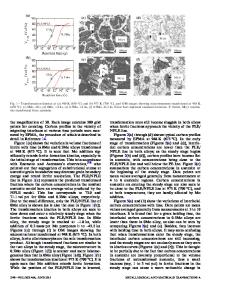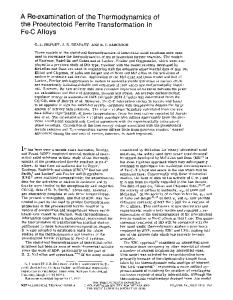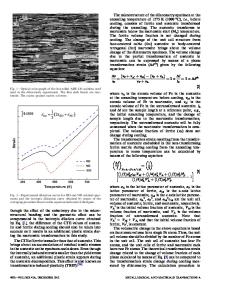Simulation of Ferrite Formation in Fe-C Alloys Based on a Three-Dimensional Mixed-Mode Transformation Model
- PDF / 685,842 Bytes
- 10 Pages / 593.972 x 792 pts Page_size
- 71 Downloads / 376 Views
ODUCTION
THE microstructure of steels, which has a strong influence on its mechanical properties, is to a large extent determined by the austenite (c) to ferrite (a) phase transformation taking place during cooling or annealing of steel slabs in the production process. Therefore, a thorough understanding of this solid-state phase transformation is of tremendous technological importance. The c fi a phase transformation in steel is a first-order transformation, which implies that the phase change takes place at a well-defined interface. In this case, the interface separates the coexisting ferrite and austenite phases, and the formation of ferrite involves a nucleation process (during which the interface forms) and a growth process (during which the interface moves). Depending on the chemical composition and the cooling conditions, the formation of a phase can take place by a displacive or diffusional mechanism, which both have a characteristic interface structure.[1] In the present article, the kinetics of the diffusional c fi a phase transformation in binary Fe-C alloys is studied. When the growing a phase has an equilibrium composition that is different from the overall composition, both the driving pressure acting on the interface and the carbon diffusion ahead of the moving interface dissipate the free energy available for transformation. It has long been a common approximation to consider S.M.C. VAN BOHEMEN and C. BOS, Researchers, are with Tata Steel Research Development & Technology, 1970 CA IJmuiden, The Netherlands. Contact e-mail: [email protected] J. SIETSMA, Professor, is with the Department of Materials Science and Engineering, Delft University of Technology, 2628 CD Delft, The Netherlands Manuscript submitted October 28, 2010. Article published online April 6, 2011 METALLURGICAL AND MATERIALS TRANSACTIONS A
that only one of these processes is controlling the growth rate of the phase transformation.[1–3] Hillert showed that the driving pressure acting on the interface is dissipated partially by the motion of the migrating interface and partially by the so-called transinterface diffusion.[4] However, in the study by Svoboda et al., it is argued that in the approximation of a sharp interface, it is justified to assume that the transinterface diffusion dissipates negligible Gibbs energy.[5] Consistent with Svoboda’s approach,[5] the present authors also assume that the driving pressure on the interface is spent exclusively by the interface migration. The transformation is essentially interface-controlled (IC) when diffusion of carbon is a relatively fast process compared to the rate at which Fe atoms transfer across the interface, which is expressed by the interface mobility. On the other hand, if the interface mobility is assumed to be very high, the transformation is said to be diffusion-controlled (DC). One of first theoretical treatments of DC growth was given by Zener,[2] and most DC models that can be found in the literature are based on his pioneering work. The description of IC growth is due to Christian
Data Loading...











